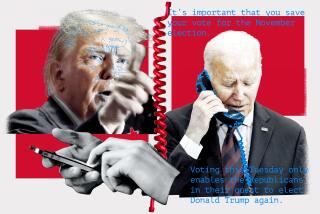BOOK REVIEW / NONFICTION : Understanding U.S. Politics in a Brave, High-Tech World : WHITE HOUSE TO YOUR HOUSE: Media and Politics in Virtual America by Edwin Diamond and Robert A. Silverman; The MIT Press $20, 178 pages
This book is about the effect on American national politics of the new developments in communications, from radio and TV talk shows to interactive media to computerized research to focus groups and instant public opinion polls.
Most of the time the authors do not like what they see.
“The shift from the old one-to-many communications model stirs talk of a brave new world of many to many communications,” they write at the outset. “Politics, the enthusiasts say, can be made democratic, participatory, open, exuberant--in a word, enjoyable.
“The triumph of politics-as-entertainment and entertainment-as-politics speeds the transformation of the national landscape. . . . We trace the emergence of a place that looks like a real democracy, and a real country, but is in fact a construct, like reality, but not real. It is Virtual America.”
Those are attention-getting words. They imply that the use of the new technology in the political process has so corrupted it as to render it a phony. I do not think that is so. Most Americans are still able, sooner or later, to separate the real from the simulated.
But the writers of “White House to Your House” do post some strong warnings about the manipulative ways the new technologies can be employed, and they do offer some shrewd observations about how easily it is to confuse the real and the virtual. Edwin Diamond is, among other things, a professor of journalism at New York University, and Robert Silverman has written for magazines.
They make the failure of the Clinton administration’s health care program a case in point. They blame its collapse on poor organization by the president and the first lady, a well-financed television attack campaign, the growth of hostile talk shows and the preference of most of the press, especially television, for concentrating on conflict instead of substance.
When you add to the media’s natural preference for conflict, they say, “the new media addiction to monomaniacal attack,” it may be “all but impossible for even the best organized, most adept White House to govern effectively.”
Diamond and Silverman argue that the limitations of modern journalism and the opportunities of the new-style media opened the way for Ross Perot, and then, after his defeat on NAFTA and his increasing implausibility as a presidential candidate, to the emergence of Newt Gingrich, “a new Perot, or rather a real Perot, rounding up suburban votes in the congressional elections to craft a Republican majority.”
The authors are most effective when they discuss the danger of erroneous statements or unproved charges or salacious rumor making it to the airways and then to cyberspace, there to be reproduced, inadequately refuted, forever.
An excellent example is the 1992 poll on the Holocaust done for the American Jewish Committee by the polling firm Roper Starch Worldwide. The published poll said one in five Americans doubted that the Holocaust had happened. There was much anguish among American Jews and many others that so many could doubt this enormous event in human history.
Then the question itself was examined: “Does it seem possible or does it seem impossible to you that the Nazi extermination of the Jews never happened?”
“As written,” the authors say,” the double negative construction was hard enough to grasp when read in its printed form; when heard over the telephone, it was even more confusing.”
A second poll was taken with the question worded this way: “Does it seem possible to you that the Nazi extermination of the Jews never happened, or do you feel certain that it did happen?”
This time, only 1% said it was possible the Holocaust never happened.
But, the authors write, “the polling community and a few other specialists who read the short follow-up articles, deep inside a few elite newspapers, noted the correction.
“Too often the follow-up articles never quite catch up with the original sensational stories. The factoid ‘one-in-five-Americans- doubt-Holocaust-happened’ became part of the intellectual junk orbiting the atmosphere. Like the debris of a spent space rocket, it was there, contaminating the air, long after its misbegotten launching.”
“The ultimate purpose of this narrative,” Diamond and Silverman conclude, “is not to argue against new communications modes, but to plead for the primacy of content in those communications. . . . If online America is to find its own Madisons or Roosevelts or Trumans, it will have to attend to the software, as always.”
More to Read
Sign up for our Book Club newsletter
Get the latest news, events and more from the Los Angeles Times Book Club, and help us get L.A. reading and talking.
You may occasionally receive promotional content from the Los Angeles Times.









